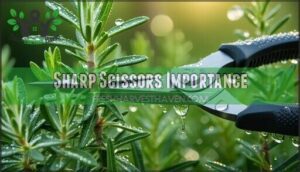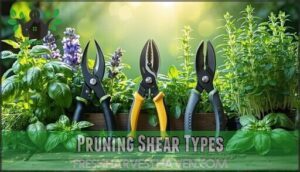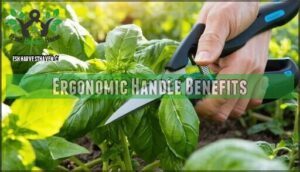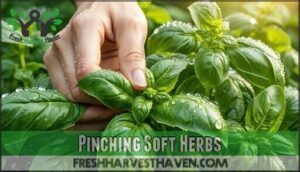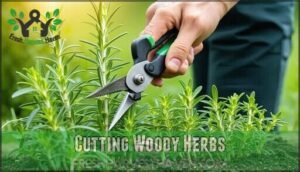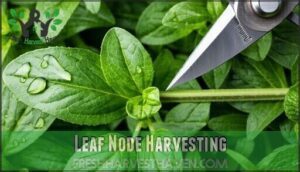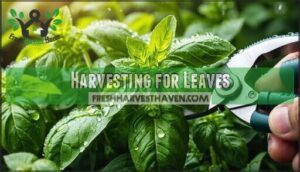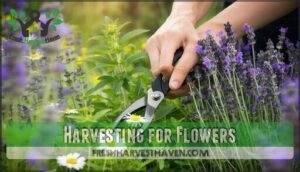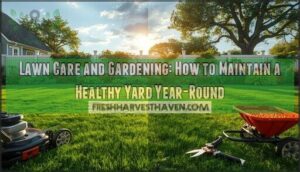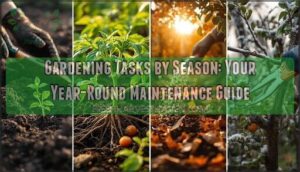This site is supported by our readers. We may earn a commission, at no cost to you, if you purchase through links.
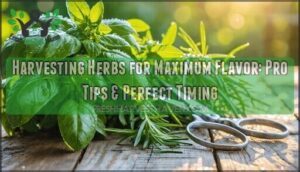
Use sharp scissors to make clean cuts just above leaf nodes, which keeps your plants producing fresh growth.
Don’t wash herbs before storing since water dilutes those precious oils you’re after.
For leafy herbs like basil, pinch off flower buds to keep leaves tender and flavorful.
Woody herbs like rosemary can handle more aggressive cutting, while delicate ones like cilantro need a gentler touch.
The secret lies in understanding each herb’s unique personality and harvesting habits.
Table Of Contents
- Key Takeaways
- Harvesting Herbs Timing
- Choosing Harvest Tools
- Harvesting Techniques
- Herb Specific Harvesting
- Maximizing Flavor Yield
- Harvesting for Leaves
- Harvesting for Flowers
- Post Harvest Storage
- Frequently Asked Questions (FAQs)
- What to do with abundance of fresh herbs?
- What is the mother of all herbs?
- What is the most flavorful herb?
- How much water do herbs need after harvesting?
- Which herbs regrow fastest after cutting back?
- Can you harvest herbs during rainy weather?
- How do you prevent herbs from wilting quickly?
- What soil conditions affect herb flavor intensity?
- Conclusion
Key Takeaways
- Harvest at peak timing – you’ll capture maximum flavor by cutting herbs in the early morning after the dew dries but before the intense sun hits, when essential oils are most concentrated
- Use sharp, clean tools – you’ll preserve essential oils and prevent plant damage by making precise cuts with sharp scissors or bypass pruners just above the leaf nodes
- Don’t wash before storing – you’ll maintain peak flavor by avoiding water that dilutes precious oils; instead, gently shake off debris and store herbs dry
- Master herb-specific techniques – you’ll get better results by pinching soft herbs like basil to encourage growth, while using firmer cuts on woody herbs like rosemary
Harvesting Herbs Timing
Timing your herb harvest can make the difference between bland and brilliant flavors in your kitchen.
You’ll want to grab those scissors first thing in the morning, right after the dew dries but before the sun gets too intense – that’s when your herbs are practically bursting with essential oils and ready to transform your cooking, which can result in brilliant flavors.
Morning harvest captures herbs at their absolute flavor peak – when essential oils are richest and most concentrated.
Morning Harvest Benefits
When the morning dew has dried, you’ll capture peak flavor in your fresh herbs.
That’s when oil concentration hits its sweet spot—plant energy is highest, and morning aroma practically sings from each leaf.
Your enhanced dishes will thank you for harvesting herbs at this magical window when herb flavor truly shines.
Peak Essential Oil Times
You’ll catch the highest essential oil concentration when harvesting herbs right before they flower – that’s your Pre-Flowering Peak sweet spot.
Morning Volatility works in your favor as aromatic compounds reach Ideal Intensity mid-morning, around 10-11 AM.
Compound Stability peaks then too, giving you maximum herb flavor before afternoon heat breaks down those precious essential oils.
Seasonal Variation affects timing, so adjust your herb harvesting time accordingly. Different herbs have varying yields, with lavender showing good results from fresh flowers.
Avoiding Intense Sun
Heat’s your herb harvest enemy—those afternoon rays basically turn your precious basil into bitter disappointment.
Afternoon sun transforms fresh herbs into flavorless disappointments—harvest before heat strikes!
Timing your morning harvest before sunlight intensity peaks protects delicate essential oils from breaking down.
Smart herb location choices, like shaded gardens or protective measures such as shade cloth, help maintain ideal planting conditions for maximum flavor retention, and delicate essential oils are preserved, which is crucial for maximum flavor.
Choosing Harvest Tools
Your choice of harvesting tools can make or break your herb’s flavor potential, so investing in the right equipment is absolutely worth it.
Sharp, clean tools protect your plants from damage while preserving those precious essential oils that give your herbs their incredible taste.
Sharp Scissors Importance
Sharp scissors aren’t just a luxury—they’re your herbs’ best friend. Clean cuts from blade sharpness prevent stem damage that crushes delicate tissues, reducing flavor and inviting disease.
Dull tools create ragged wounds that stress plants and open infection pathways. Proper tool maintenance keeps your herb harvesting methods effective.
When you make precise cuts with quality herb harvesting tools like pruning shears, you’re practicing disease prevention while maximizing your garden’s potential. Investing in high quality shears guarantees clean cuts and is a key part of proper tool maintenance.
Pruning Shear Types
You’ll want to choose the right pruning shears for your herb harvesting toolkit. Bypass vs anvil makes a huge difference – bypass shears create clean cuts like scissors, while anvil types can crush delicate stems and reduce flavor.
- Bypass pruners: Perfect for live, tender herb stems – they preserve essential oils by minimizing cellular damage
- Ratchet pruners: Great for thick, woody herbs like rosemary when you need extra cutting power
- Micro-tip shears: Ideal for precision work on delicate herbs and microgreens
Consider herb bypass pruners for superior results.
Ergonomic Handle Benefits
Extended harvesting sessions become a breeze when you’re gripping comfortable herb snips with spring-loaded handles.
You’ll notice reduced hand fatigue even after hours of clipping basil and oregano.
Enhanced grip strength means improved cutting precision, letting you make those perfect cuts above leaf nodes.
Consider ergonomic scissor options for efficient harvesting.
Comfortable tool use transforms herb harvesting techniques from chore to pleasure, making these herb tools absolutely worth the investment.
Harvesting Techniques
The secret to harvesting herbs isn’t just knowing when to cut—it’s mastering how you cut to keep your plants happy and productive.
Different herbs need different approaches, from gentle pinching for delicate basil to strategic cutting above leaf nodes for woody rosemary.
Getting this right means the difference between a thriving herb garden and sad, stressed plants, and it requires understanding the unique needs of each herb to ensure they remain productive.
Pinching Soft Herbs
Your hands are the perfect tool for soft herb types like basil, cilantro, and parsley.
Pinching techniques using your fingertips encourage bushier growth by stimulating new shoots below the cut.
Gently pinch stems just above leaf nodes, which preserves essential oils better than crushing cuts from dull tools.
This tool alternative method enhances flavor while promoting continuous harvests throughout the growing season.
Cutting Woody Herbs
Woody herbs like rosemary, sage, and thyme need a tougher approach than their tender cousins.
Use bypass pruners for thick stems, cutting at a 45-degree angle to prevent water pooling.
Select younger, green woody stems over old, bark-heavy branches that taste bitter.
Cut sparingly—these slow growers don’t bounce back quickly from aggressive harvesting, so patience pays off for maximum herb flavor enhancement.
Leaf Node Harvesting
Beyond simply cutting stems, mastering leaf node harvesting transforms your herb garden into a flavor powerhouse.
This herb harvesting technique focuses on precise placement of cuts to encourage node regrowth and branching encouragement, ultimately boosting herb leaf quality through strategic plant health management.
- Cut just above leaf nodes – Tool precision guarantees clean cuts that promote vigorous branching encouragement
- Leave two sets of leaves below – This herb harvesting timing maintains plant health while maximizing regrowth potential
- Angle cuts slightly – Proper herb harvesting techniques prevent water pooling and disease at cut sites
- Target young growth – Fresh nodes respond faster to herb flavor enhancement through active regeneration
Herb Specific Harvesting
Each herb has its own personality and needs special attention to bring out its best flavors.
You’ll want to master the unique harvesting approach for your most-used herbs like basil, mint, and oregano since getting their timing and technique right makes all the difference in your cooking.
Basil Harvest Methods
Pinching technique works best for basil – grab those top leaves between your thumb and forefinger, then gently twist.
This encourages bushier growth while preventing bolting.
Always cut stems just above leaf nodes for continuous harvest.
Young leaves pack more flavor punch than mature ones, so don’t wait too long.
Regular stem cutting every 2-3 weeks keeps your basil producing fresh, aromatic leaves all season long.
Mint Harvest Techniques
Since mint thrives with aggressive harvesting, you’ll want to cut stems 1-2 inches above ground level to encourage rapid regrowth.
Here are five essential mint harvest techniques:
- Morning timing – Harvest after dew dries when oil levels peak for maximum aroma
- Young leaf focus – Target tender leaves with higher menthol concentrations for stronger flavor profile stages
- One-third rule – Never harvest more than 33% at once to prevent stress and maintain herb regrowth
- Clean cuts – Use sharp tools to prevent bruising and preserve mint variety impact on flavor
- Pre-flowering harvest – Cut before blooms appear to conserve volatile oils responsible for distinctive scent
Regular harvesting frequency every 2-3 weeks keeps your mint productive while maximizing herb flavor through proper herb harvesting techniques.
Using sanitized tools helps to prevent disease spread.
Thyme and Oregano Harvest
For thyme and oregano, timing is everything when you’re chasing that perfect flavor intensity. Harvest these woody herbs just as flower buds appear but before they fully bloom—that’s when their essential oils peak.
Use sharp scissors to cut young stems, avoiding the old woody parts that’ll taste bitter. Remember, stressed oregano actually develops more intense flavors, but don’t overdo it—you still want those harvesting techniques to keep your plants healthy and productive!
| Herb | Ideal Height | Stem Cutting Method | Regrowth Strategy | Harvest Frequency |
|---|---|---|---|---|
| Thyme | 6+ inches | Cut young stems above leaf nodes | Leave 2/3 of plant intact | Every 2-3 weeks |
| Oregano | 4-6 inches | Trim before flowering | Never remove more than 1/3 | Weekly during peak season |
| Both | Mature growth | Sharp, clean cuts only | Support central growth | Monitor for flower buds |
| Woody Stems | Avoid completely | Risk bitter flavors | Focus on tender shoots | Check twice weekly |
| Peak Flavor | Just before bloom | Morning harvest ideal | Pinch buds regularly | Extend harvest season |
Maximizing Flavor Yield
You’ll capture peak flavor by avoiding water on freshly harvested herbs, since washing immediately dilutes those precious essential oils you worked so hard to preserve.
Cut your herbs right before tossing them into your dish—this timing trick prevents oxidation and keeps those vibrant flavors from escaping into thin air, which helps to preserve the essential oils.
Avoiding Washing Herbs
After harvesting your herbs, resist the urge to wash them immediately—you’ll preserve more flavor this way.
Dirt removal should be gentle; simply shake off loose soil or debris instead of dunking them under water.
This minimal handling approach prevents flavor loss and keeps essential oils intact.
For retaining flavor while preventing mold, store unwashed herbs in breathable containers.
Save the gentle cleaning for right before cooking to maximize herb freshness and flavor enhancement.
Cutting Herbs Just Before Use
You’ll lock in immediate flavor when you cut herbs right at cooking time. Fresh cuts release maximum aroma and preserve those volatile oils that make your dishes pop. Think of it like opening a bottle of perfume – that first burst is pure magic.
- Cut stems underwater to prevent air bubbles from blocking water uptake
- Use sharp kitchen shears instead of knives to avoid bruising delicate leaves
- Snip directly into your pan or bowl to capture every drop of those precious oils
This timing trick keeps oxidation reduction at its peak while maintaining cooking freshness that’ll make your culinary herbs sing. For the best results, consider the morning harvest to maximize essential oil concentration.
Minimizing Oxidation
Once you’ve cut your herbs, work quickly to prevent flavor-robbing oxidation.
Sharp, clean tools create less cellular damage than dull blades.
Store herbs unwashed in breathable containers, and refrigerate within 20 minutes of harvesting.
These simple enzyme inhibition techniques preserve those precious antioxidant compounds that make your herbs shine.
Harvesting for Leaves
When you’re harvesting leafy herbs like basil, mint, or parsley, you’ll want to focus on the tender young leaves that pack the most flavor punch.
Cut branching herbs just above a leaf node to encourage bushy growth, while ground-emerging herbs like chives can be snipped right down to soil level for continuous harvests.
Leafy Herb Harvesting
Beyond traditional watering schedules, leafy herbs like basil and parsley demand strategic herb harvesting techniques to release their peak herb flavor potential.
Your herb harvesting guide should emphasize harvest frequency—picking outer leaves weekly encourages maximum growth while maintaining ideal leaf size.
This harvesting impact triggers natural regrowth strategies, ensuring your leafy herbs stay productive and flavorful throughout the season, which is crucial for maintaining their peak herb flavor potential.
Branching Herb Techniques
Two essential herb cutting strategies maximize your garden’s branching potential and boost overall plant health.
When you master these pruning methods, you’ll see dramatic improvements in harvesting frequency and herb flavor:
- Cut above leaf nodes – This encourages branching by triggering new growth from dormant buds
- Remove flower buds early – Prevents energy redirection and maintains ideal growth patterns
- Harvest regularly – Frequent herb cutting stimulates continuous production and better herb harvesting techniques
Ground Emerging Herbs
Chives, parsley, and similar ground emerging herbs need frequent cuts right at soil level for maximum regrowth stimulation.
This harvesting frequency—every two weeks during growing season—keeps these herbs tender and flavorful.
Always use sterilized tools to protect root health, as these herb harvesting best practices guarantee continuous production and maintain herb flavor throughout the season.
Harvesting for Flowers
When you’re harvesting herbs for their stunning blooms, timing becomes your secret weapon for capturing peak flavor and visual appeal.
You’ll want to snip those flower heads just as they’re opening or right before they reach full bloom, since that’s when their essential oils are most concentrated and their colors are absolutely vibrant.
Flower Bud Removal
When you’re growing herbs for their leaves, you’ll want to pinch off those flower buds before they fully develop.
This simple trick redirects the plant’s energy back into producing more flavorful leaves instead of flowers, extending harvest season and preventing bolting.
Regular bud removal keeps your herbs focused on leaf production, enhancing flavor and promoting growth throughout the growing season.
Harvesting Open Flowers
When flowers reach their prime, you’ll capture Edible Flower Harvest at peak Floral Flavor Intensity.
Bloom Stage Matters tremendously—harvest when blossoms are almost or just opened for maximum herb flavor. This timing protects Pollinator Impact while ensuring ideal taste.
Cut entire flower heads cleanly, following proper herb harvesting guidelines that preserve both plant health and Seed Saving potential for future seasons.
To maximize aroma and vase life, harvest during early morning hours.
Drying Flower Heads
Once your flower heads reach perfect drying stages, you’ll want to clip them into paper bags for seed collection.
This method prevents mold prevention issues while ensuring fragrance retention and color preservation.
Label each bag immediately – trust me, dried herbs look surprisingly similar.
Proper drying maintains that amazing herb aroma you’ve worked hard to cultivate, ensuring color preservation and overall quality, which is crucial for seed collection.
Post Harvest Storage
Once you’ve harvested your herbs at the perfect time, proper storage becomes essential for maintaining that peak flavor you’ve worked so hard to capture.
The right preservation methods can keep your herbs tasting fresh for months, while poor storage will rob them of their essential oils within days.
Drying Herbs Methods
Once you’ve gathered fresh flowers, proper drying preserves their flavor and extends shelf life.
Air drying works best—bundle stems with rubber bands and hang upside down in a dark, well-ventilated space.
For faster results, try oven drying at the lowest temperature or use a dehydrator. These herb drying techniques guarantee you’ll have aromatic seasonings year-round.
Freezing Herbs Techniques
Your freezer becomes a time machine when you master proper herb freezing techniques that lock in peak flavors for months.
Smart preparation methods guarantee your herbs taste garden-fresh even in winter’s depths.
- Ice Cube Freezing: Chop herbs, mix with olive oil or water, freeze in ice cube trays for easy portioning
- Blanching Benefits: Quick steam bath before freezing preserves color and prevents enzyme breakdown
- Vacuum Sealing: Remove air completely to prevent freezer burn and maintain herb texture
- Oil Infusion: Blend herbs with oil before freezing to create ready-to-use flavor bombs for cooking
Preserving Herb Flavor
Beyond freezing methods, you’ll want to master other herb preservation techniques to keep that garden-fresh flavor year-round.
Oil infusions capture aromatic compounds beautifully, while vinegar extracts provide tangy herb essence.
Salt curing works wonders for heartier herbs like rosemary.
To maintain the aroma of herbs infused in oil, it’s vital to use proper container material.
These drying techniques and preservation methods guarantee your herb harvesting efforts pay off deliciously, with a focus on aromatic compounds.
Frequently Asked Questions (FAQs)
What to do with abundance of fresh herbs?
Don’t let abundance become a burden!
Freeze herbs in ice cube trays with olive oil, make herb butter, or create pesto and chimichurri sauces.
You’ll preserve their peak flavors for months ahead.
What is the mother of all herbs?
You’ll find many herbs called the "mother of all herbs," but parsley truly earns this title.
It’s packed with vitamins, enhances every dish, and grows reliably in your garden year-round.
What is the most flavorful herb?
Like a symphony conductor orchestrating flavors, basil reigns supreme as the most flavorful herb.
You’ll discover its sweet, peppery notes with hints of anise create culinary magic that transforms ordinary dishes into extraordinary experiences.
How much water do herbs need after harvesting?
Freshly harvested herbs don’t need water—they’re already packed with moisture! Instead, you’ll want to keep them dry and cool to preserve those essential oils that deliver incredible flavor.
Which herbs regrow fastest after cutting back?
Annual herbs bounce back fastest—basil can regrow in just 7-10 days after cutting.
You’ll see chives, cilantro, and dill sprouting new growth within a week, while mint practically explodes back overnight, making them perfect for frequent harvesting.
Can you harvest herbs during rainy weather?
You shouldn’t harvest herbs during rainy weather since wet leaves lose essential oils and bruise easily. Wait until plants dry completely after rain for peak flavor and proper storage.
How do you prevent herbs from wilting quickly?
While delicate herbs seem fragile, you’ll keep them vibrant by harvesting with sharp, clean tools and immediately placing stems in cool water like fresh flowers.
What soil conditions affect herb flavor intensity?
Well-drained, slightly alkaline soil with moderate fertility produces herbs with the most concentrated essential oils.
You’ll get stronger flavors when your herbs experience mild stress from lean conditions rather than overly rich, nitrogen-heavy soil that promotes leafy growth.
Conclusion
Like Rome, great herb gardens aren’t built in a day, but mastering harvesting herbs for maximum flavor transforms your cooking overnight.
You’ve learned the golden rules: morning timing, sharp tools, and respecting each herb’s unique needs.
Skip the pre-wash, cut above nodes, and pinch those flower buds religiously.
Whether you’re snipping delicate cilantro or robust rosemary, these techniques guarantee peak flavor in every leaf you harvest.
- https://www.linkedin.com/pulse/indoor-herb-gardens-grow-fresh-flavors-your-richard-la-faber-ggnkc
- https://www.milkandhoneyherbs.com/blog/2019/7/26/harvesting-amp-drying-herbs-for-the-home-apothecary
- https://growagoodlife.com/harvest-dry-herbs/
- https://www.letimestill.com/blog/essential-oil-yield-from-different-herbs
- https://pmc.ncbi.nlm.nih.gov/articles/PMC4243263/

